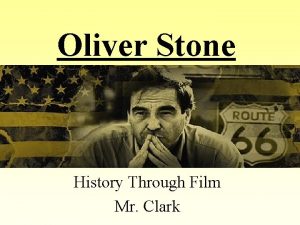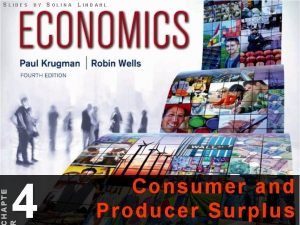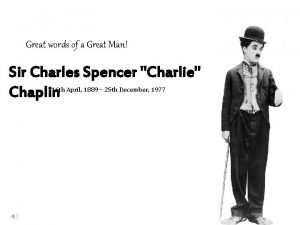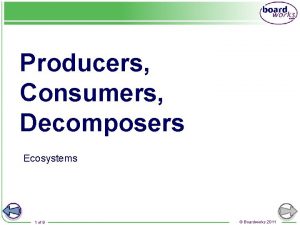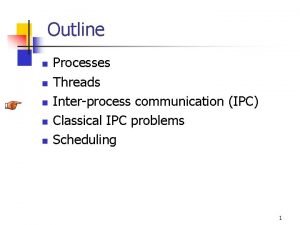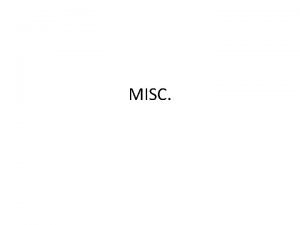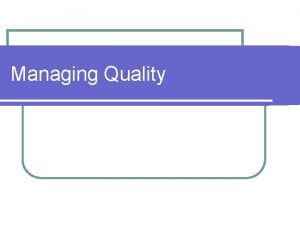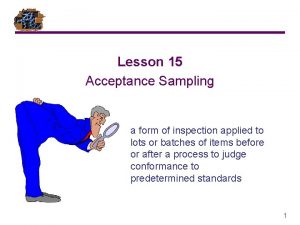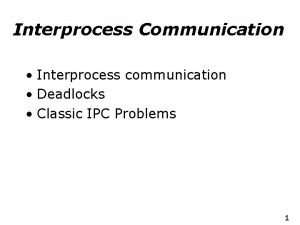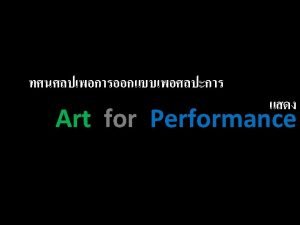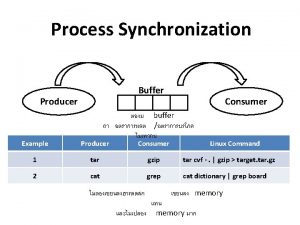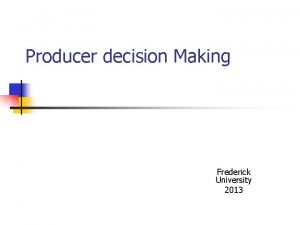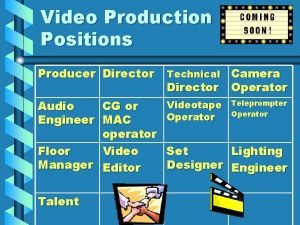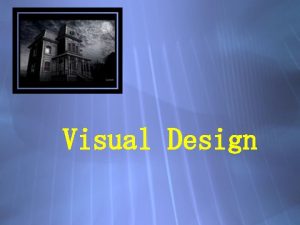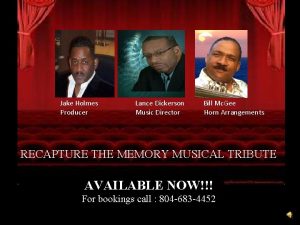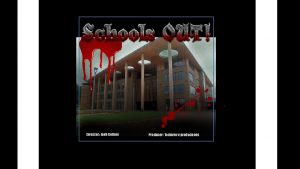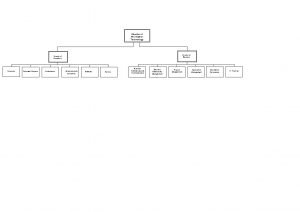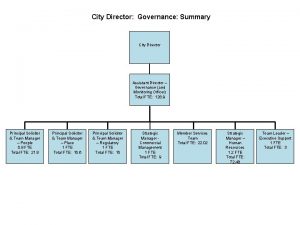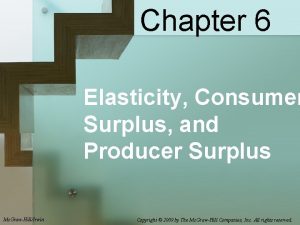The Director and the Producer Chapter 5 The































- Slides: 31

The Director and the Producer Chapter 5

The Director is the The Director shapes eye of the audience. a production for an audience.

Three Approaches to Directing: 1. Traditional – The text-based method 2. Auteur – Author Directors who put their own message into the script 3. Postmodern – Began in late 19 th century with directing that broke long held taboos (avant-garde, experimental & others) The Traditional Director “The Director and the Script”

The Script is the basis for the production and message to the audience. • • • Choosing a script Spine of a script Style of the production The “Directorial Concept” The Director and the Dramaturg

The Director Task #1 What is th e Spine? The Spine of a play is the main action determined by the goal or primary objective of the characters in the play, collectively and individually. The Spine is also known as the through-line or center point of the play action.

The Spine of the Play Defining the spine of a play for a director provides him/her the identity of the nerve center of the play. “Antigone” – which angle should a director choose • • • Heroism and bravery of Antigone The dilemma of a leader A woman’s plight in life during the time period What to emphasize?

The Director The Style of the Production Task #2 The Director chooses the way in which a play is presented. Realism • Naturalism-Attempts to put on stage exact copies of everyday life; sometimes also called “slice of life” • Heightened Realism-Also called “selective realism” where actors perform with suggestions of furniture or skeletal scenery while acting as if in real life

The Director The Style of the Production Task #2 The Director chooses the way in which a play is presented. Nonrealism • Allegory-The symbolic representation of abstract themes through characters, action and other concrete elements of a play • Expressionism-The attempt in drama to depict the subjective state of a character or group of characters through quiet nonrealistic techniques as distortion, striking images, and poetic language

The Director The Style of the Production Task #2 The Director chooses the way in which a play is presented. Style in a play can be depicted in several ways: • The look of the scenery and lights • The way performers speak • The costumes and props • The rhythm and pace of the play

The Director The Style of the Production Task #2 The Director chooses the way in which a play is presented. 2 Essential elements of using style to a traditional director: 1. The style should be appropriate to the play, honoring the playwright’s intent 2. The style should be consistent throughout every aspect of the production

The Directorial Concept and Period The Director can choose to change the period of the play if it stays true to the essence of the play. Concept and Central Image The Director can choose to use a central controlling image or metaphor to convey the essence of the play that is in line with the intent of the playwright.

The Directorial Concept and Purpose The best concept of a play is one that remains true to the spirit and meaning of the script. Gimmickry in a play takes away from its purpose and meaning.

The Director and the Dramaturg Duties are invaluable to Directors • Discover promising new plays • Helping playwrights develop their scripts • Identify plays from the past that should be brought to life • Prepare material for teachers and their students • Writes articles about the play and performances • Marketing the play performance

Three Approaches to Directing: 1. Traditional – The text-based method 2. Auteur – Author Directors who put their own message into the script 3. Postmodern – Began in late 19 th century with directing that broke long held taboos (avant-garde, experimental & others) The Auteur Director “Author Directors”

The Director authors his/her own script to the production of the play. • Generally the script is non-existent • The director stages the actors and moves them to act and to create a script based on the director’s point of view (usually avant-garde). • Vsevolod Meyerhold (1874 -1940) developed a kind of theatre in which he controlled all the elements (including using a script to springboard into a new creation of his own script).

The Director Auteur “Author” Following Meyerhold’s footsteps were other avant-garde auteur directors Jerzy Grotowski Richard Foreman Robert Wilson

Three Approaches to Directing: 1. Traditional – The text-based method 2. Auteur – Author Directors who put their own message into the script 3. Postmodern – Began in late 19 th century with directing that broke long held taboos (avant-garde, experimental & others) The Postmodern Director “The Taboo/Experimental Director”

The Postmodern Directors’ subject matter included explicit sexual content, social diseases, the subjugation of women, and the hypocrisy of some religious figures. • Deconstruction of scripts where text could be altered, deleted, re-arranged or taken out of context • Abandonment of narrative or linear structure of the play • Unfamiliar, cross-gender, multicultural casting

The Director and the Production The Physical Production The Director must work with the designers of the play. • The Director confers with the costume, scene, lighting and sound designers to give visual shape and substance to the director’s concept.

The Director’s work with the Performers The Director casts the play. The Director supervises all rehearsals. The Director blocks the actors. • Blocking: Pattern and arrangement of performers’ movements onstage with respect to each other and to the stage space set by the director.

The Director’s work with the Performers Casting is fitting performers into the roles of the play. • Typecasting-the performer closely resembles the characteristics of the role of the character in the play • Casting against type-used for comic or satiric purposes • Audition for a play-actors try-out for a role in the play • Historically, acting companies or guilds were formed which avoided the need to have actors audition for a role in the play as is regularly practiced today, except for some famous “stars”

The Director’s work with the Performers Rehearsals “Practice makes perfect” • The Director guides, shapes and supervises the practice and movement and rhythm of the performers and scenery. He/she motivates and molds the actors into who he/she believes the characters should be. The director envisions and blocks the action of the characters based on his/her interpretation of how the characters relate to each other and to theatre space. He/she moves the actors to work as an ensemble.

The Director’s work with the Performers Rehearsals • • Generally, rehearsals begin with the director, actors; and sometimes designers (if a musical, the composer or conductor) sitting around each other. The actors read their parts in character to get a flavor of the play. The director explains his/her point of view of the play and characters. He/she conveys his/her concept and spine of both the play and some major characters. The script is broken down into segments or scenes and the director instructs the actors and crew on the rehearsal schedule (what will be practiced or needed when) The director will set the time of when the actors will be “off book” and can no longer call for a “line”.

The Director’s work with the Performers The Director as the Audience’s Eye • The Director stands in for the audience before the play is publically performed. • Placing “characters” in certain physical relationship to each other and inside theatre space can form a “picture” for the audience to use to relate to the play. • The “movie” director has even more control over what the audience sees.

The Director’s work with the Performers Movement, Pace and Rhythm The Director gives shape and structure to a play through • Space • Time (movement, pace and rhythm) • Pick up the cues • Movement and rhythm of actors on stage (Does it fit the mood of the play and does it keep the audience interested)

The Director’s work with the Performers Technical Rehearsal • The performers are onstage in their costumes with the scenery, lighting, sound and sound effects. • The tech crew spots the cues for their technical performance and rehearses scene changes, costume and makeup changes/adjustments, props placement/movement and etc. • Complete “run-throughs” are rehearsed and adjusted.

The Director’s work with the Performers Dress Rehearsal • The dress rehearsal is the first full performances before performances for the public. • It is designed to pretend there is an audience watching, therefore there are no stops or “fixes” during the performances. • It’s time to find out what works and doesn’t. • “The play must go on” LIVE before an audience no matter what happens, so the actors and crew must rehearse how to adjust “on their feet” when something doesn’t go as expected.

The Director’s work with the Performers Previews • Previews are tryout performances of a production before an audience, preceding the official “opening” performance. • Previews are used to test the performer-audience relationship which is crucial in a theatrical performance of a play.

The Producer or Managing Director The Producer- In American usage, the person responsible for the business side of production, including raising the necessary money. In British usage, a producer for many years was the equivalent of the American director. The Managing Director- In non-profit theatre organizations, the individual who controls resources and expenditures.

The Producer or Managing Director The Commercial Producer • • • Raise money to finance the production Secure rights to the script Deal with the agents for the playwright, director and performers Hire the director, performers, designers and stage crew Deal with theatrical unions Rent theatre space (if needed) Supervise the box office, auditorium and business office Supervise the advertising Oversee the budget and week-to-week financial management of the production

The Producer or Managing Director Noncommerical Theatres • • Adminstrative organization of a non-profit theatre • Board of Directors • Artistic Director • Executive or Managing Director Responsibilities of a noncommercial managing director • Maintenance of theatre building • Keeps productions under budget, balancing artistic and financial needs • Responsible for publicity • Maintains box office, programs for productions, secures ushers for “front of the house” and other details
 Director vs producer
Director vs producer Whats a decomposer
Whats a decomposer Consumer and producer surplus
Consumer and producer surplus How to calculate consumer and producer surplus
How to calculate consumer and producer surplus When are consumer and producer surplus maximized?
When are consumer and producer surplus maximized? Producer surplus
Producer surplus Producer and consumer surplus graph
Producer and consumer surplus graph Detritivores
Detritivores Function of ecosystem
Function of ecosystem English comic actor and film director
English comic actor and film director English comic actor and film director
English comic actor and film director English comic actor and film director
English comic actor and film director Total surplus formula
Total surplus formula Acceptance sampling procedure
Acceptance sampling procedure Producer definition geography
Producer definition geography Taxation and government intervention
Taxation and government intervention Qualified producer
Qualified producer Is a cockroach a consumer producer or decomposer
Is a cockroach a consumer producer or decomposer Types of consumers in ecosystem
Types of consumers in ecosystem Producers consumers and decomposers
Producers consumers and decomposers Is a cockroach a producer consumer or decomposer
Is a cockroach a producer consumer or decomposer Producer-consumer problem
Producer-consumer problem Income stream formula
Income stream formula Producer's risk
Producer's risk Double sampling
Double sampling Producer-consumer problem
Producer-consumer problem Primary consumers and secondary consumers
Primary consumers and secondary consumers Producer's risk
Producer's risk Producer gas is a mixture of
Producer gas is a mixture of Kookaburra food web
Kookaburra food web What do the arrows on the food web represent
What do the arrows on the food web represent Extended producer responsibility
Extended producer responsibility
